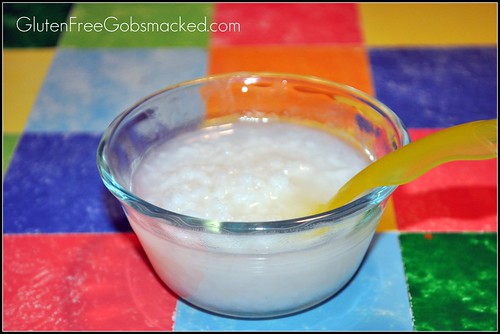GF: Basic congee

So the photo is just the little bit left from lunch the other day. The babe was still eating her congee as she just can’t get enough somedays.
I’ve written about this simple rice porridge before – how it soothed my stomach after food poisoning overseas; how my husband’s family uses this as a staple (and swears by the powers of the rice “broth” for feeling better when you are ill); etc. It’s so good – that people have begun getting worried that I wasn’t going to post the recipe.
I guess my delay in posting the “recipe” is that there really are so many varieties, ways and ideas for what you can do that there really is NO recipe for this. It varies by family, province, country, etc. But there are some basics for you to know before you toss your rice into a pot and get cooking.
THE BASICS
It’s important to note that rice porridge (congee or jook) is meant to be cooked longer than you would normally cook/steam rice. You want the rice to break down and the rice starch to naturally thicken the broth. In order to achieve this, you want to do the following:
- Use a rice to water ratio that is at least 1:8. For example, toss 1/2 cup of rice (not Minute Rice, not Uncle Ben’s processed rice – just regular old rice) in to 4 cups of water. (Yes, that says 4 cups!)
- Bring it to a boil and then lower the heat to a simmer. Stir frequently to keep the rice from sticking to the bottom of the pan and to help develop a creamier texture.
- Simmer with a lid covering MOST of the top (leave it open about an inch or so to avoid it overflowing!) for 45 minutes or so. At this point, you should be able to stir the rice and see that it has thickened the liquid (which is now more like a stew broth – thick and delicious!) and you will see that the rice has broken down.
- Now add salt to taste. And Wah-lah! You have a basic rice porridge.
- You can now eat your porridge as it (which we often do) or you can top it with the traditional chopped green onions as well.
THE VARIATIONS
There are so many things you can do with this that you will find a never ending list of “gotta-try-that”s in your brain once you taste the deliciousness of this super-simple soup. Here’s a list of some of the things that we have done:
- Heat a little oil in the pan and quickly saute some chopped garlic until aromatic. THEN add your rice, water and salt. MMMMM.
- Use chicken stock instead of water (or veg stock, or… etc).
- Better yet: Remember that GF rotisserie chicken you picked up for dinner but didn’t really finish? Put that into a huge stock pot, cover with water and toss in your rice. Boil this for a couple hours. The carcass will break down and the meat will be tender and fabulous mixed into the congee. (You may/may not need to add seasoning/salt – depends on your chicken.)
- Make the congee with a ham bone instead of that leftover chicken.
- At the end of cooking, add some rinsed black beans and some chopped up tiny pieces of meat. (This is Zoe’s second favorite version. Second only to the basic version above.)
- Add traditional Chinese ingredients, like Thousand Year Old (aka preserved) duck egg or a splash of GF soy sauce instead of the salt.
- Add some chopped up pieces of white fish just at the end of cooking and boost your protein power. You only need to cook for a few minutes longer for the fish to cook through if you chop it up.
- Whisk an egg (or two) in a small bowl, the stir the egg into the cooked congee.
- Sauté some small chopped carrot and onion pieces, add a bit of garlic then add your rice and a bit more water (like 1:9 ratio or 1:10 – depending on how thick you like your congee) and cook away.
Really… the variations are endless.
The structure or basics are not set in stone. The ratio can vary depending on how thick you prefer your congee. I wouldn’t suggest using a ratio of less than 1:6 as then you end up with mushy rice and not a porridge at all. And a ratio of greater than 1:12 makes for some watery rice soup. But hey – it’s personal preference!
I order congee for myself and the Chicklet when my honey has a craving for dim sum. It’s gluten free – but be careful! Some restaurants like to top their congee with shredded wonton skins. Just say no to those as they are not gluten free and avoid the traditional Chinese donut (a long fried not-sweet bread) that is always typically served with congee. I guess that’s the beauty of having a (1) baby along because they always ask if the baby would like those things (LOL!) and (2) a native Cantonese speaker in the mix. 🙂
I hope this post finds you all well and enjoying your fall. Life is grand around here – so much so that we are even considering adding another family member in the form of a 11 month old pup. (As though one toddler weren’t enough for me……..)
Happy GF Eating!
And don’t forget to come back and post your favorite congee variation!
I’m up for some new ideas!
~Kate